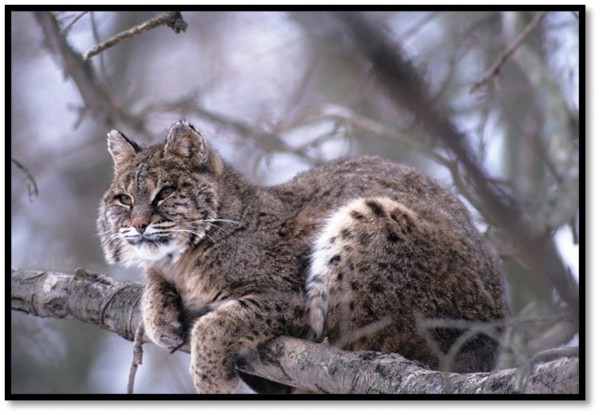Bobcat

Bobcat
Lynx rufus
-
The bobcat is our most-seen member of the cat family, though it is still uncommon in some areas of Wisconsin.
-
They average 20-30 lbs., and have light brown fur with spots and a short tail with black bands on the top of the tail.
-
Historically a northern Wisconsin species, in recent years sightings have increased in the central and southern portions of the state.
Population: Bobcat populations are currently harvested in the northern 1/3 of Wisconsin, north of State Highway 64. Increased interest in bobcat harvest, coupled with a perceived population increase and expansion in Central Wisconsin, has resulted in consideration of expansion of harvest opportunities. Little is known about bobcat populations in Central Wisconsin.
Habits: Bobcats are on the move during the twilight hours of sunrise and sunset during the summer, but they spend time hunting on winter days. Each week they travel around 2.6 miles to move between resting areas, food sources, or hunting areas. Bobcats do have to beware of predators like hawks, owls, and eagles that prey on their young kittens, or coyotes that eat the bobcat's food out of the same area.
Thickly forested areas of northern Wisconsin are home to the bobcat. They like alder thickets and coniferous swamps. In the southern part of the bobcat's range, they prefer upland areas when conifer swamps aren't found. Male bobcats cruise a 25 square mile area and females only 15 miles in range. Fights can be prevented between bobcats since they mark their territory boundaries with feces, urine, and gland secretions. Young bobcats may wander as much as 100 miles across the land to find an unoccupied territory to make their home.
Diet: The snowshoe hare and cottontail rabbit are the major prey of Wisconsin bobcats. These cats will look for sick, injured, very young, or old white-tailed deer if a rabbit meal isn't easily available. They also like larger mammals for a meal like a porcupine, squirrel, and woodchuck. They'll chase and eat smaller animals such as mice, voles, shrews, reptiles, birds, and even insects.
Mating and Young: Like all cats, bobcats can breed year-round, though they usually only have one litter of 2-four kittens per year. Bobcats are solitary except when breeding.
Information from: https://dnr.wi.gov/topic/WildlifeHabitat/research/carnivores.html and https://www.eekwi.org/animals/mammals/bobcat
To download this information: Click Here
